
Celtis is a genus of about 60–70 species of deciduous trees, commonly known as hackberries or nettle trees, widespread in warm temperate regions of the Northern Hemisphere. The genus is part of the extended hemp family (Cannabaceae).

Carl Borivoj Presl was a Czech botanist.
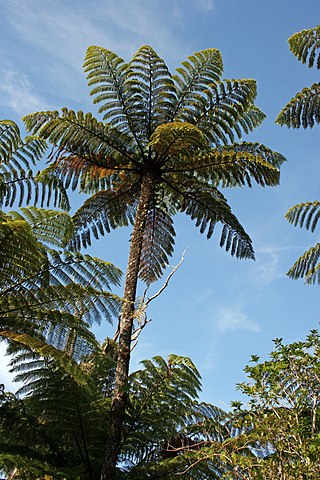
Cyathea is a genus of tree ferns, the type genus of the fern order Cyatheales.

Sebastiania is a genus of flowering plants in the family Euphorbiaceae first described in 1821. It is native to North and South America from Arizona and the West Indies south to Uruguay.
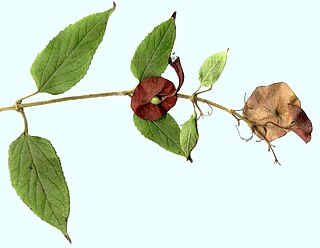
Holmskioldia is a genus of flowering plants in the mint family, Lamiaceae. It is native to the Himalayas but widely cultivated as an ornamental and naturalized in many places It contains only one known species, Holmskioldia sanguinea, commonly called the Chinese hat plant, cup-and-saucer-plant or mandarin's hat.
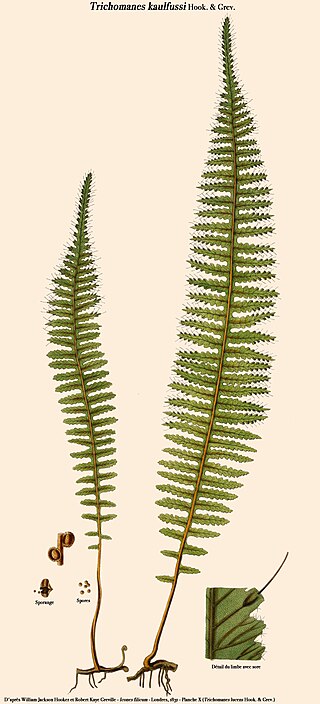
Trichomanes is a genus of ferns in the family Hymenophyllaceae, termed bristle ferns. The circumscription of the genus is disputed. All ferns in the genus are filmy ferns, with leaf tissue typically 2 cells thick. This thinness generally necessitates a permanently humid habitat, and makes the fronds somewhat translucent. Because of this membrane-like frond tissue, the plant is prone to drying out. “Filmy ferns” in the taxa Hymenophyllaceae grow in constantly wet environments. Many are found in cloud forests such as “Choco” in Columbia. There are also members of the taxa that can grow submersed in water.
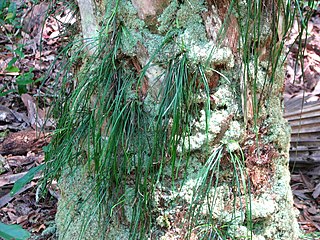
Vittaria, the shoestring ferns, is a genus of ferns in the Vittarioideae subfamily of the family Pteridaceae. It had previously been placed in the family Vittariaceae, but that family is no longer recognized.
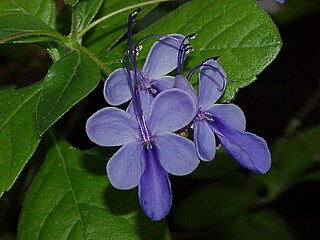
Rotheca is a genus of flowering plants in the family Lamiaceae. Estimates of the number of species in the genus vary from about 35 to as many as 60. Three of the species are native to tropical Asia, with the rest occurring in Sub-Saharan Africa. The type species for the genus is Rotheca serrata. It had originally been named Rotheca ternifolia, but this name is now considered illegitimate.

Lindsaea, common name necklace fern, is a genus of around 180 species of fern, 15 of which reach Australia. The name is in honour of surgeon John Lindsay of Jamaica. The genus is sometimes spelt Lindsaya.
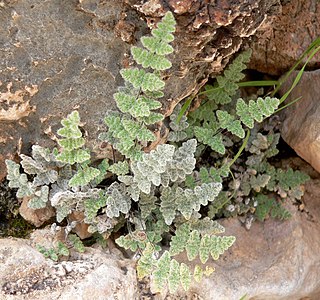
Cheilanthoideae is one of the five subfamilies of the fern family Pteridaceae. The subfamily is thought to be monophyletic, but some of the genera into which it has been divided are not, and the taxonomic status of many of its genera and species remains uncertain, with radically different approaches in use as of December 2019.

Karomia is a genus of plants in the family Lamiaceae. The genus was introduced in 1932 by the botanist Paul Louis Amans Dop (1876-1954) in 'Bulletin du Muséum national d'histoire naturelle' (Paris) ser. 2. 4: 1052, for the single species Karomia fragrans. It is native to eastern and southern Africa, Madagascar, and Vietnam.
- Karomia fragransDop – Vietnam
- Karomia gigas(Faden) Verdc. – Kenya, Tanzania
- Karomia humbertii(Moldenke) R.Fern. – Madagascar
- Karomia macrocalyx(Baker) R.Fern. – Madagascar
- Karomia madagascariensis(Moldenke) R.Fern. – Madagascar
- Karomia microphylla(Moldenke) R.Fern. – Madagascar
- Karomia mira(Moldenke) R.Fern. – Madagascar
- Karomia speciosa(Hutch. & Corbishley) R.Fern. – Mozambique, Swaziland, South Africa
- Karomia tettensis(Klotzsch) R.Fern. – Mozambique, Malawi, Zimbabwe, Zambia

Serpocaulon is a genus of ferns in the family Polypodiaceae, subfamily Polypodioideae, according to the Pteridophyte Phylogeny Group classification of 2016 (PPG I). The genus is native to Northern and Southern America.
Caiophora is a genus of flowering plants belonging to the family Loasaceae.
Klotzschia is a genus of flowering plants belonging to the family Apiaceae. It is native to Brazil.
Streptopetalum is a genus of flowering plants belonging to the family Passifloraceae.
Tricliceras auriculatum is an annual herb native to Nampula Mozambique.
Tricliceras bivinianum is an annual herb in Tricliceras, Turneroideae (Passifloraceae). It's endemic to Sudan Ethiopia, Tanzania, Zanzibar, and Madagascar. T. bivinianum can grow up to 0.5 meters tall and produce yellow flowers.
Tricliceras brevicaule is a perennial herb native to Africa.There are two varieties of T. brevicaule:brevicaule and rosulatum. The varieties can be identified by the shape of their petals. Variety brevicaule has petals with pointed ends, while rosulatum has rounded ends. T. brevicaule var. brevicaule can be found in bushlands and grasslands of Kenya, Tanzania, Mozambique and Zambia. T. brevicaule var. rosulatum can be found in the forests, woodlands, and roadsides of Kenya, Tanzania, Malawi, Mozambique and Zambia.












